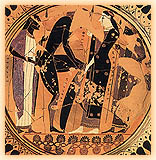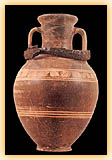 |
| At the peak of the social pyramid was a small group of powerful families,
the aristoi,
who shared common values and were characterized by a mentality
that considerably differed from that of the other members of society. The rule
of this limited elite was based on wealth and the exclusive
and effective exercise of its military, political, judicial and religious role in the
community. |
 The point
of departure and main criterion of distinction for aristocrats was origin. The elite of the Homeric
poems frequently refers to the genos and the reputation of their ancestors.
Among the aristocrats there was a tendency either to trace their lineage back to heroes
and gods,
or to make heroes of some of their ancestors and attribute superhuman deeds
to them. Their mythical pedigree invested them with a divine origin whilst, at the same time,
justifying their being part of the aristoi class. The characterizations
diogeneis and diotrepheis (descended from Zeus) are initially attributed to basileis and reveal
the belief of the heroes-aristocrats concerning their superiority, their descent
from the father of gods and men. The point
of departure and main criterion of distinction for aristocrats was origin. The elite of the Homeric
poems frequently refers to the genos and the reputation of their ancestors.
Among the aristocrats there was a tendency either to trace their lineage back to heroes
and gods,
or to make heroes of some of their ancestors and attribute superhuman deeds
to them. Their mythical pedigree invested them with a divine origin whilst, at the same time,
justifying their being part of the aristoi class. The characterizations
diogeneis and diotrepheis (descended from Zeus) are initially attributed to basileis and reveal
the belief of the heroes-aristocrats concerning their superiority, their descent
from the father of gods and men.
|
 The
aristocrats
were warriors par excellence and this supremacy was due to various factors.
From an early age they would receive appropriate training and devote a lot of time
to the training of their body and fighting spirit. Only aristocrats
could be appointed chiefs of phratries and phylae and would get other offices as well.
The chiefs of phratries and phylae, or others among the elderly and more
experienced aristocrats, formed the counselling bodies. They were also at the head
of religious ceremonies, considered indispensable for the security of the
community. The
aristocrats
were warriors par excellence and this supremacy was due to various factors.
From an early age they would receive appropriate training and devote a lot of time
to the training of their body and fighting spirit. Only aristocrats
could be appointed chiefs of phratries and phylae and would get other offices as well.
The chiefs of phratries and phylae, or others among the elderly and more
experienced aristocrats, formed the counselling bodies. They were also at the head
of religious ceremonies, considered indispensable for the security of the
community. |
| These privileges enhanced the prestige of the aristocrats. Their economic
supremacy derived from their prominent position as warriors and determinants of the state.
In return for their services offered in sectors vital for the survival of the community, they
were entitled to a larger share in the distribution of land
and booty. Lastly, due to their better economic status, they could keep large flocks and have
thetes and slaves in their service. |

 The point
of departure and main criterion of distinction for aristocrats was origin. The elite of the Homeric
poems frequently refers to the genos and the reputation of their ancestors.
Among the aristocrats there was a tendency either to trace their lineage back to heroes
and gods,
or to make heroes of some of their ancestors and attribute superhuman deeds
to them. Their mythical pedigree invested them with a divine origin whilst, at the same time,
justifying their being part of the aristoi class. The characterizations
diogeneis and diotrepheis (descended from Zeus) are initially attributed to basileis and reveal
the belief of the heroes-aristocrats concerning their superiority, their descent
from the father of gods and men.
The point
of departure and main criterion of distinction for aristocrats was origin. The elite of the Homeric
poems frequently refers to the genos and the reputation of their ancestors.
Among the aristocrats there was a tendency either to trace their lineage back to heroes
and gods,
or to make heroes of some of their ancestors and attribute superhuman deeds
to them. Their mythical pedigree invested them with a divine origin whilst, at the same time,
justifying their being part of the aristoi class. The characterizations
diogeneis and diotrepheis (descended from Zeus) are initially attributed to basileis and reveal
the belief of the heroes-aristocrats concerning their superiority, their descent
from the father of gods and men.
 The
aristocrats
were warriors par excellence and this supremacy was due to various factors.
From an early age they would receive appropriate training and devote a lot of time
to the training of their body and fighting spirit. Only aristocrats
could be appointed chiefs of phratries and phylae and would get other offices as well.
The chiefs of phratries and phylae, or others among the elderly and more
experienced aristocrats, formed the counselling bodies. They were also at the head
of religious ceremonies, considered indispensable for the security of the
community.
The
aristocrats
were warriors par excellence and this supremacy was due to various factors.
From an early age they would receive appropriate training and devote a lot of time
to the training of their body and fighting spirit. Only aristocrats
could be appointed chiefs of phratries and phylae and would get other offices as well.
The chiefs of phratries and phylae, or others among the elderly and more
experienced aristocrats, formed the counselling bodies. They were also at the head
of religious ceremonies, considered indispensable for the security of the
community.